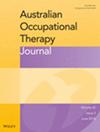Use of sensory processing information in the diagnosis of autism spectrum disorder and attention deficit hyperactivity disorder in children at an Australian community hospital
Abstract
Introduction
The provision of sensory processing information is one aspect of occupational therapy involvement in diagnostic assessment for autism spectrum disorder and attention deficit hyperactivity disorder. The aim of this study was to retrospectively compare SHORT Sensory Profile 2 results of children with suspected diagnoses and assess the discriminatory ability of modified scales of SHORT Sensory Profile 2 to identify diagnostic criteria.
Method
This study involved a retrospective chart audit of SHORT Sensory Profile 2 results and paediatrician letter of diagnosis (N = 92) for children aged 6–13 years who had multidisciplinary diagnostic assessment through outpatient paediatric service.
Consumer and Community Involvement
No consumers participated in the study design or analysis. Study involved retrospective analysis of de-identified results from caregiver assessments.
Results
Forty nine per cent of children in study sample had confirmed diagnosis of attention deficit hyperactivity disorder, and 26% had diagnosis of autism spectrum disorder. Average percentage scores for both behavioural and sensory components of the SHORT Sensory Profile 2 were highest amongst children with a diagnosis of autism spectrum disorder, as well as higher classification for avoiding and seeking quadrants. In relation to modified scales, Cronbach's alpha indicated high internal consistency for inattention (0.84) and social communication and interaction (0.86). Based on the ROC analyses, the discriminatory ability when all the modified scales are used in combination ranged from poor (original four quadrants to distinguish ADHD vs no diagnosis: AUC = 0.59) to good (ASD vs ADHD; AUC = 0.82; ASD vs no diagnosis (AUC = 0.81).
Conclusion
Results of this study highlight the need for more rigorous investigation for validation of modified scales and consensus within occupational therapy and multidisciplinary team in relation to reporting of sensory processing information and contribution to diagnostic criteria.
PLAIN LANGUAGE SUMMARY
Many children with attentional difficulties or autism require information from occupational therapists about their sensory issues to help inform and identify behaviours of concern. This study looked at how a sensory processing screening tool can identify traits related to attentional difficulties and autism in children. Seventy-eight medical charts of children from a community hospital were reviewed. This study showed that information from the sensory processing screening tool related to attention and social communication traits. Clinicians can consider using information from a sensory processing screening tool in combination with other assessments to contribute to the identification of attention difficulties and autism in children.


 求助内容:
求助内容: 应助结果提醒方式:
应助结果提醒方式:


